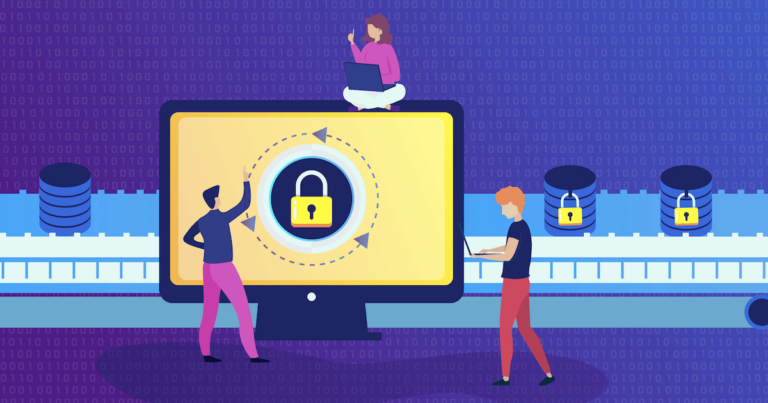Endpoint security is a cybersecurity practice performed to secure endpoints such as desktops, laptops, servers, and fixed-function devices from all types of malicious acts that could be triggered from internal or external sources. Endpoints are connected through a network and can communicate with other points and devices across the network. While these connected devices form endpoints on a network, they are often the starting point of a cyberattack. This makes securing endpoints crucial, especially in a corporate environment, where sensitive business data is at stake.
Unlike traditional information security practices that focus on only prevention and detection from known malware attacks, endpoint security focuses on proactive approaches and overall strategy in place for enterprise data security. It relies on intelligent services to establish an advanced platform to ascertain issues. It provides a complete technology stack, not just for prevention from threats and attacks but also to detect, disrupt, prevent, monitor, and track the whole round of intrusions.
Why Do Enterprises Need Strong Endpoint Security?
Threat actors often employ sophisticated malware to alter network and other confidential data on enterprise servers and workstations for malicious purposes. Once they get privileged access, they compromise imperative business data or disrupt mission-critical applications without being detected. Henceforth, security practitioners and IT teams consider endpoint security platforms, tools, and technologies as a significant layer of defense against a spectrum of malware and threat vectors.
Outlined below are some of the major areas where endpoint security helps:
1. Accurate and actionable threat detection:
It is important to detect an attacker’s presence on the network ASAP, and for that, organizations need enhanced functionalities and technologies. Integrating endpoint security within an enterprise boosts their threat hunting programs provides a clear understanding of the user, network, and app activity. It pinpoints any threats that could pose a risk to the firm. The increased capabilities enhance team efforts by prioritizing events that pose the biggest risks to an organization and making them truly actionable.
2. Automated and orchestrated defenses:
Enterprises need a standardized response workflow to combat cyberattacks. Endpoint security provides real-time visibility into and across enterprise infrastructure and offers the ability to orchestrate countermeasures at an enterprise scale. It allows teams to consistently resolve issues faster and contain threats more effectively.
3. Next-gen network security integration for threat disruption at scale:
Network security is undergoing a radical evolution, thanks to global enterprise digital transformation initiatives, the rise of the cloud, and the dissolution of the enterprise perimeter. Since most users, apps, and the data they access are no longer housed in a data center, network security inspection, analysis, and policy enforcement need to be done elsewhere. Endpoint security measures allow teams to inspect network security close to the edge, provide threat intelligence, and enable them to make quick, accurate, and safe decisions.
Read the importance of cloud security and the 12 best practices to stay abreast of it.
Top 11 Best Practices for Efficient Endpoint Security
With increasing malicious attacks and cyber criminal activities, enterprises have developed and implemented the best procedures and practices to operate day-to-day business operations. Here are some of the best practices promising endpoint security enterprises are currently following to secure their network, data, applications, and people from threats.
1. Secure every endpoint
As one of the gateways to your network, you should maintain an inventory of all endpoint devices, apply appropriate safeguards for each device, and ensure these have the latest patches to ensure secure endpoints.
2. Practice stronger password usage
Good password practices ensure strong security for the systems. Henceforth, make longer, complex passwords mandatory and encourage periodic password changes and repetition of old password usage.
3. Implement encryption
Encryption provides an additional layer of security that works beyond passwords. Encrypted things are inaccessible by others and are one of the best security features in scenarios when devices are lost or transferred to another unit.
4. Ensure least privilege access
Limiting access and device privileges saves you from unauthorized executable code being loaded onto devices by regular users. The processes help you design privileged access to only authorized users.
5. Run continuous endpoint scans
Encourage constant location awareness of devices connected to the network, such as mobile devices and laptops, vulnerable to loss or theft.
6. Enforce automated patching
Practice automatic push of patch updates during downtimes unless critical instead of relying on users to do it on their devices.
7. Apply multi-factor authentication
Implement multi-factor authentication as a second layer of verification when logging in from unauthorized devices and unrecognized locations.
8. Implement a strict VPN access policy
Network infrastructures are prone to spoofing, sniffing, or DDoS attacks. Limit your VPN usage to enable access only at the application level for preventing the risk of a network-level attack.
9. BYOD safety
BYOD protection is very important as these come with some major security risks. If you encourage a culture of using BYOD, you must have a policy that outlines security rules, emphasizing end-user responsibilities; protocols should be followed strictly when the device is lost or stolen. You can also consider using a guest access account.
10. Segment the network
Split your network into subnetworks to attain better performance and security. Setting up a separate infrastructure allows for managing and updating privileged resources.
11. Consider cloud as an endpoint
Cloud is just another endpoint and could be accessed by external parties. Therefore, treat the cloud as an endpoint, always use TLS (HTTPS) to transport data, and apply a distinct credentials system for each user to ensure security thoroughly.
Leverage Predictive Analytics and Big Data to Better Secure Your Endpoints
Endpoint security is about moving to a predictive security model. It focuses on preventive methods instead of reactive as the traditional security model used to be – identifying malware variants and patching known vulnerabilities. Since the adversary is constantly inventing new attack methods that are just different enough to go undetected, Predictive Analytics and Big Data can be used to secure endpoints.
There is a huge volume of data available on past attacks and the behavior of attackers. These big data could be put to use to identify evolving attack tactics, techniques, processes, and even root causes. Executed with sophisticated algorithms in the cloud, organizations can employ predictive analytics to collect knowledge and insights that help them identify weak points, address them proactively, and stay one step ahead of even the smartest attackers.
Conclusion
Limitations of existing security models and increasing decentralization practices across all aspects of the organization have required better secure endpoints. Endpoint security platforms infused with big data and advanced analytics can offer you capabilities to resolve vulnerabilities before they can be exploited by cybercriminals and enable automated disaster recovery for business continuity.




